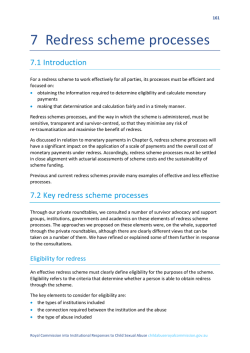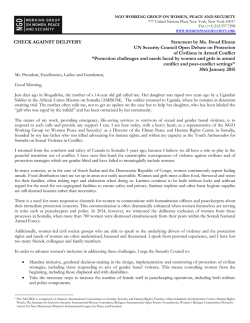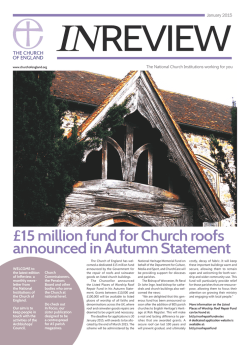
Redress and civil litigation The Hon Justice Peter McClellan AM
Redress and civil litigation The Hon Justice Peter McClellan AM Chair, Royal Commission into institutional Responses to Child Sexual Abuse It is just over two years ago since the Royal Commission was appointed. In that time the Commissioners have spoken with over 2,850 survivors in private sessions. Each session reveals a unique personal story of betrayal of a child’s trust with, for many, life-long consequences. Many survivors speak of losing their childhood. Others speak of losing the benefits which come from a stable family and the rewards which come from personal and career achievements. All who have been abused suffer in some way. A picture is emerging for the Commissioners that although the sexual abuse of children is not confined in time – it is happening today – there has been a time in Australian history when the conjunction of prevailing social attitudes to children and unquestioning respect for the authority of institutions by adults coalesced to create the high risk environment in which thousands of children were abused. 1 The societal norm that ‘children should be seen but not heard’ which prevailed for unknown decades, provided the opportunity for some adults to abuse the power which their relationship with the child gave them. When the silence required of the child was accompanied by an unquestioning belief by adults in the integrity of the carer for the child – whether they were a youth worker, teacher, residential supervisor or cleric - the power imbalance was entrenched to the inevitable detriment of many children. When, amongst adults given the power, there are people with an impaired psycho sexual development, a volatile mix is created. Our Terms of Reference require us to make recommendations in relation to ‘ensuring justice for victims through the provision of redress by institutions’. Many institutions have acknowledged that their previous response to survivors has been inadequate. Many survivors have a pressing need for assistance, including effective and just redress. For these reasons, the Commissioners accepted that we should consider the issue of redress and make final recommendations in relation to it as soon as possible. A reading of our Terms of Reference, which have been adopted by every Australian government, suggests that there is universal agreement amongst governments that ‘justice for victims’ requires appropriate redress. Our discussions with institutions have confirmed that every major institution also 2 accepts that effective redress is required if victims are to receive justice. Everyone recognises that redress is not only about money. Furthermore, an effective redress scheme cannot offer common law damages. The fundamental object of redress must be to help those who have suffered to heal and live a productive and fulfilled life. Conscious of the complexity of the issues involved in redress the Commissioners have undertaken an extensive program of consultation. We published issues papers on: civil litigation; redress schemes; statutory victims of crime compensation schemes; and Towards Healing. We have also held a coordinated program of roundtables involving governments, institutions, survivors and others. From this consultation program we have developed a major consultation paper which I release today. I regret that it is a lengthy document. However, there are many questions to consider and the complexities cannot be avoided. The Commissioners now seek submissions in response to the consultation paper from interested parties so that our final report can be published in the middle of this year. The closing date for submissions is Monday 2 March. The Commissioners will receive oral submissions at a public hearing over three days commencing on Wednesday 25 March. 3 As the need for effective redress has apparently been accepted by all governments and many institutions, we are endeavouring to provide recommendations for redress which meet the criteria of justice, practicality and affordability. We understand that this issue emerges in an economic climate where governments must be particularly careful in committing public monies to areas not presently funded. However the need having been accepted, it is important that governments and institutions respond. It is necessary for me to stress that the Commissioners do not presently have firm views about any issue in the consultation paper. We are seeking informed comment to assist us in forming our final views. When considering the requirement for justice through redress, it is inevitable that the opportunity provided by the civil law for a victim to recover compensatory damages must be examined. Although there are many hurdles that a survivor faces in prosecuting a claim for damages, for some this course provides the possibility of recovering a money sum in excess of that which could be provided by any redress scheme. In recent years there have been considerable developments in the manner in which the law, in some countries, approaches the liability of institutions for the sexual abuse of children entrusted to the care of the institution. In simple terms, the law in England and Canada has developed so that depending on the 4 circumstances, an institution owes a duty of care to children entrusted to it which may be breached by the deliberate and criminal act of a ‘member’ of the institution, without negligence on the part of the institution itself. Although Australian law has not taken this step it is not difficult to contemplate a duty which is owed by an institution which is absolute in nature. Where an institution holds itself out as providing for the welfare and development of a child, being an organisation which a parent may entrust with the care of their child and the child is abused, many people would expect the institution to be accountable. A crime committed by a member of the institution becomes the responsibility of the institution itself. Inherent in the contemporary response of the law in England and Canada to these issues is an acceptance that an institution carries an unqualified obligation to care for any child entrusted to its care. The apparent acceptance by government and institutions in Australia of the need for effective redress, although not in the amount of common law damages, reflects an acceptance of a similar obligation by governments and institutions. The significant questions are of course what should be the elements of redress, how should it be provided and how can it be adequately funded. 5 The consultation paper contains a detailed discussion of these issues. It suggests that effective redress must have three elements – personal response by the institution to the survivor, guaranteed funding when needed for counselling and psychological care and a money sum which is paid in recognition of the wrong done to the individual. We have considered options for the formation and ongoing management of a redress scheme. It is clear that a scheme should be structured so that the decision making about redress is independent of the institution in which the abuse occurred. It is also clear that survivors want a scheme that will treat them fairly and equally, regardless of the institutions in which they were abused. Many people prefer a single national scheme administered by the Australian Government. Institutions would contribute to the funding of the scheme in accordance with their responsibility to individual survivors and in addition would meet their relative proportion of the costs of the scheme’s administration. An alternative considered in the paper is to provide individual State and Territory based schemes which adopt and are administered in accordance with common national principles. Individual institutions would contribute in the same manner as they would contribute to a national scheme. This option 6 would require the Australian Government to at least contribute to State and Territory schemes in respect of survivors who were abused in Commonwealth run institutions. Another alternative is for individual institutions, either alone, or combining together to provide and administer their own independent scheme also in accordance with common national principles. This would leave governments to either provide their own schemes, but in accordance with the common national principles, or join in a scheme with institutions. At this stage of the development of a possible redress scheme various assumptions must be made. They include the number of survivors, their need for counselling and its likely cost, and the amount considered to be adequate as a money sum. To assist us in identifying appropriate assumptions we have engaged a firm of actuaries. The consultation paper draws upon their work. The actuaries’ paper is available on the Royal Commission website. Critical to the modelling of a possible redress scheme is the assumption which is made as to the number of survivors who may be eligible. The actuaries have carefully analysed the Western Australian Government scheme to determine the number of people who were accepted to be entitled to redress for sexual abuse they suffered as a child. From this analysis and using other data, they 7 have estimated the number of survivors who may be entitled to some level of redress nationally to be 65,000. We know from our private sessions that some survivors will need lifelong counselling and psychological care, while others will need care from time to time. There are existing services, including specialist sexual assault services and public funding through Medicare, that help some survivors to obtain at least some of the counselling and psychological care that they need. However, we have learnt that existing services are not adequate. There are a number of service gaps. We discuss some possible options in the consultation paper which might ensure that survivors’ needs for counselling and psychological care are met. One option is to significantly expand the public provision of appropriate counselling services, either through changing Medicare requirements or through a stand-alone government program. Another option is to establish a trust fund that would operate as part of a redress scheme. It is important that any counselling and psychological care provided through redress should supplement existing public services, and not displace or compete with them. We seek all interested parties’ views in relation to counselling and psychological care. We will endeavour to make recommendations that ensure 8 survivors’ needs are appropriately met in a way that does not adversely affect existing services. There are many considerations relevant to the appropriate money sum, including fairness and affordability. The consultation paper considers various options with a cap of $100,000, $150,000 or $200,000. These are used to assist an understanding of the situation. Of course, other options may be appropriate. It is important to appreciate that the possible cost of a scheme is not significantly dependant on the cap but rather on the spread of amounts within the cap and the resulting average payment which may be appropriate for individual survivors. The consultation paper considers how those amounts might be determined. It suggests that relevant criteria could be severity of abuse – 40 per cent, impact of abuse – 40 per cent and distinctive institutional factors – 20 per cent. Other approaches are possible. Average payments of $50,000, $65,000 and $80,000 are modelled. A significant issue in our discussions has been the provision which should be made for survivors who were abused in institutions which no longer exist and for which there is no successor or overarching organisation. There are also survivors who were abused in institutions which have no money. If these survivors are to benefit from a redress scheme the funding must come from 9 either government or other institutions. The issue of funder of last resort is important if, as our Terms of Reference contemplate, the community is to ensure justice for victims through the provision of redress. When designing a redress scheme it is necessary to acknowledge that many institutions and some state governments have already provided redress in different forms. Payments already made by these schemes would have to be offset. This would also be the case where a survivor has received a common law award or settlement. Various possibilities are discussed in the paper for adjusting for past payments. Our actuarial advisers have conducted detailed modelling of the possible costs of a redress scheme. The two critical assumptions are the number of eligible survivors and the average cost of payments under the scheme. The consultation paper includes the modelling that assumes 65,000 eligible survivors and average payments of $65,000. Based on these assumptions, the total cost of redress nationally would be in the order of $4.378 billion. This number will of course vary depending on the assumptions which are made. The cost of redress would be spread over a number of years. The actuaries have provided an indicative 10 year model. That model indicates that, adopting the same assumptions of 65,000 eligible survivors and average payments of $65,000, the maximum cost in any one year is likely to be in the order of 10 $650 million nationally. This would be funded by contributions from both governments and institutions. If government is the funder of last resort, and continuing with the same assumptions of 65,000 eligible survivors and average payments of $65,000, a contribution of $1.971 billion would be required from all governments of which $582 million reflects the contribution as funder of last resort. $2.407 billion would be the contribution required from private institutions. I should again stress that these numbers change if the assumptions change and if a different level of average payment is chosen. It is important to emphasise that although it appears that governments must accept a broader role in providing effective and fair redress, the primary responsibility is with the institution, whether government or otherwise, in which a survivor was abused. That institution must provide an appropriate personal response and be responsible for funding the counselling and money sum for each person abused in that institution. Accepting that effective redress through a redress scheme should be available, it is nevertheless necessary to ensure that survivors have appropriate access to the possibility of common law damages. 11 Apart from the issue of the duty of care, a number of other issues in relation to civil liability are discussed in the paper. It must now be clear from the work we have already completed that limitation periods of three, six or even 12 years will be inadequate to allow many victims time to come to the position where they are able to give an account of their abuse and provide information from which the damage which they may have suffered can be assessed. For some people the betrayal of the trust inherent in abuse by an adult inflicts such profound damage that it may be 20 years or longer before the person is able to talk of their experience. For many it is not until that time or more has passed that they come to understand that they have been damaged and for the first time seek assistance in coping with the psychological trauma. We know that some people who are abused move on from the experience with minimal impact on their lives. Others will experience trauma which in their later life may require a level of intense care. The consultation paper raises the question of amendments to the statutes of limitations which may be appropriate for survivors. As I have indicated, it is necessary to consider the elements of the duty of care which should be imposed upon an institution and the occasions for its breach. The paper discusses the English and Canadian position. If change is appropriate legislation would be required by each State or Territory. 12 Related to the duty of care issue is the question of the appropriate onus of proof. Instead of the victim being required to prove a breach of the duty of care, should the institution be obliged to prove that it took all reasonable steps to care for the child? If made, this would be a significant change but many would support it because of the increased discipline it would impose on institutions. Each of these questions raises a series of complex sub-issues. They are all considered in the consultation paper. During the course of last year, and after discussions with the Attorney General, who has been supportive of the Commission’s work, we reported to the Australian Government that it was necessary, if we were to appropriately complete our tasks, that we be funded for two years beyond the original three years provided in the Letters Patent. The Australian Government agreed and we are now funded to provide our final report by – December 2017. The Commissioners are committed to complete our work by that time. The Commissioners have throughout our work been conscious of the need to engage with people in regional areas. Apart from many people who we have assisted to travel for a private session in a city, the Commissioners have spoken with many people by telephone. We have now conducted private sessions in the regional centres of Rockhampton, Woorabinda, Launceston, Cairns, the 13 Kimberley, Geelong, Ballarat, Bendigo, and Coffs Harbour. In first half of 2015, we have programed private sessions, including some return visits, in the regional centres of Lismore, Newcastle, Townsville, Launceston, Cairns, Warrnambool, Shepparton and the Tiwi Islands. Depending on the number of people wanting a session in particular locations, we will arrange private sessions in other regional centres. We have also held private sessions in a number of metropolitan and regional prisons and we have planned further private sessions at prisons in 2015. We have now completed 21 public hearings. We have forwarded nine reports of hearings to government of which six have been released. A number of further reports are close to completion. Our future program of public hearings contemplates seventeen hearings this year. The program will end in early 2017. This will allow time for the Commissioners to complete private sessions and develop comprehensive policy recommendations. It is apparent that our capacity to conduct public hearings could never allow a hearing into every institution in which abuse has occurred. We must be selective. The decisions in relation to which institutions to examine in a public hearing are made to cover a broad range of institutions having regard to geographical location, type of institutions and the character of the provider. Eventually the choice reflects the concentration of institutional types which 14 feature more predominately in the information we are gathering, including from private sessions. On Monday we will commence a public hearing in Melbourne which will examine allegations of child abuse against four individuals of Yeshiva Melbourne and Yeshiva Bondi. This will be followed by a hearing in Sydney which will explore allegations in relation to Knox Grammar School. We will then turn our attention in a public hearing to out of home care. In April the Commission will travel to Rockhampton where the public hearing will focus on the experiences of children at St Joseph’s Orphanage, Neerkol, which was managed by the Sisters of Mercy. The case study will also examine the conduct of priests attached to the Diocese of Rockhampton who carried out duties at the Orphanage. In May we will travel to Ballarat, a regional centre with a deeply disturbing history of institutional sexual abuse. The hearing will commence in May but is likely to require further sittings at a later date. The first part of the hearing will hear of the experience of many survivors and the damaging impacts which the abuse has inflicted on the social fabric of the community and the families within the community. 15 Our Terms of Reference require the Commissioners to examine systemic failures by institutions in relation to incidents of child sexual abuse to enable best practice to be identified so that it may be followed in the future. Two imperatives are identified. Firstly to protect against the occurrence of child sexual abuse, and secondly to respond appropriately when any allegations and incidents of child sexual abuse occur, including holding perpetrators to account and providing justice to victims. To assist in defining our work the Letters Patent identify four areas of particular significance to which our inquiries should be directed. With these areas in mind, the Commissioners have identified the major policy areas which we must investigate with a view to developing appropriate recommendations for change. Our work in this area is supported by a comprehensive program of research. We have already completed and published reports in relation to seven research projects. Three more reports will be published in February. We have also published seven issues papers. Details are available on the Royal Commission website. Early in our work we identified a need to provide recommendations in two areas as soon as possible. The first is redress and civil litigation. The other issue is working with children checks, about which I would like to say a few words. 16 It may come as a surprise to many people that although discussed by governments for years, Australia still does not have a national or otherwise uniform system for checking the pre-employment history of a person who seeks to work in a paid or voluntary capacity with children. This is a significant failure by government which must be rectified. As we know our federal structure of government is accepted as bringing many benefits, however there are some areas where the complexities which result from differing perspectives and expenditure preferences create difficulties. A uniform system of checks for those who seek to work with children has proved to be one of those areas. Because, although the need is obvious, the criteria which should be adopted has been controversial, the Commissioners decided that these issues should be addressed early in our work and a report provided to Government. Our primary consultation work in this area is now complete. Further detailed discussions are presently taking place and I anticipate that we will publish the final report on this issue in May of this year. It is to be hoped that all governments will respond to the issues raised in a constructive and timely manner. A national framework for working with children checks is long overdue. Its absence is a blight upon the communities’ efforts to provide effectively for the protection of children. 17 Finally, this morning I should reflect on the response which is already evident from both governments and institutions to the issues raised by the Royal Commission’s work. It has been overwhelmingly positive reflecting a general acceptance of the need for us all to do more to protect our children. The cooperative goodwill between institutions, governments and survivor groups was evident in our roundtable meetings. These were always productive with every participant expressing a determination to effectively respond to the issues. We are also aware of significant changes in the general community. Apart from the efforts of major institutions to repair the outcome of previously inadequate redress responses of which each, or at least part, of the Anglican, Salvation Army and some Catholic communities have committed themselves, our work is bringing change to the policy and practices of many institutions involved with children. We know of the work which the YMCA is doing to respond to its identified problems and we understand many other childcare providers have moved to review their practices and ensure they meet a suitable standard. We are also working with the Australian Olympic movement to develop effective policies and practices across all Olympic sports which involve children. 18 We have also learnt of the development by appropriately skilled organisations of audit programs to ensure that institutions adopt and achieve best practice in the care of children. Apart from the 493 matters we have referred to the Police for investigation we know that more people than previously are bringing allegations directly to the Police for investigation. As I have indicated, we have provided a rigorous timetable for consideration of the consultation paper on redress and civil litigation. We have done this because we know that there are many survivors who are frail or ageing who are entitled to an effective response through redress for their abuse. By releasing this consultation paper today, we are encouraging anyone with an interest in the issue to provide a submission to us. This may be done by making a written submission or by providing comments in a short online form. I stress that no one should assume the Commissioners have a final view on any issue. We are seeking submissions which will help us to establish our views and provide recommendations which are just, practical and affordable. 19 20
© Copyright 2026






